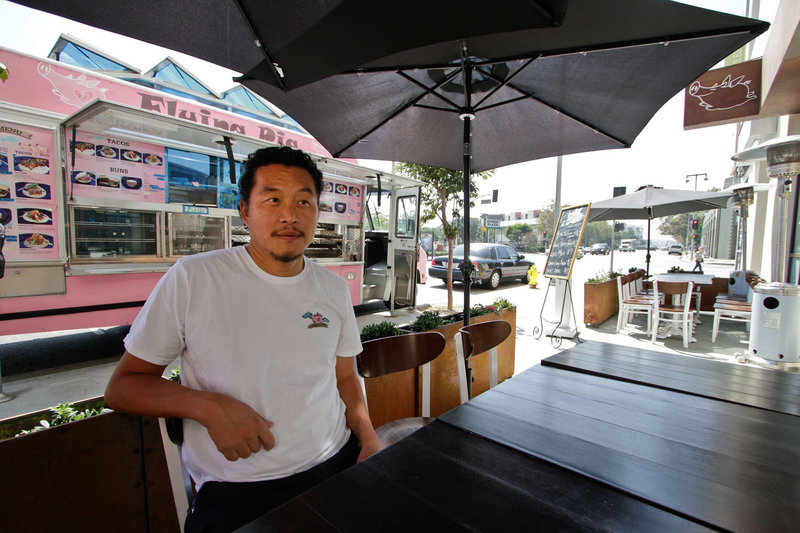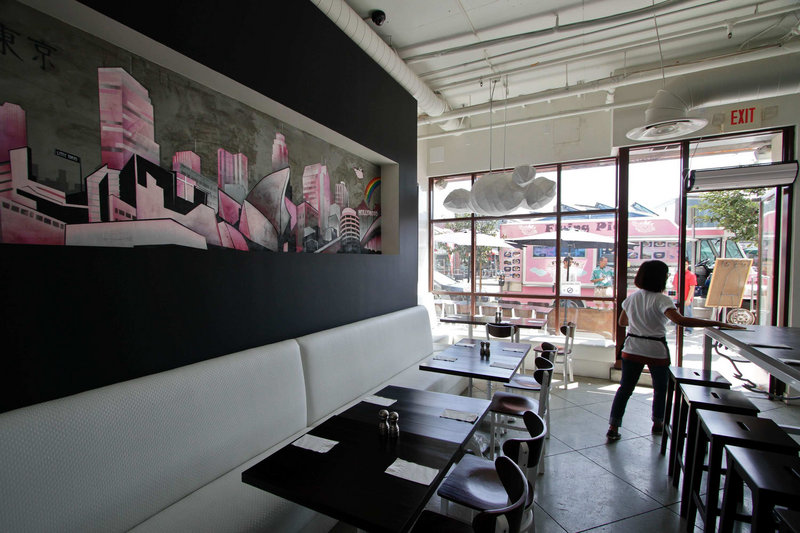LOS ANGELES — The food truck revolution is moving indoors.
The owners of some of the most successful trucks are using the knowledge, fame and bankability gained from operating their mobile eateries to start sit-down restaurants.
“To grow a restaurant from the ground up is impossible,” said Eric Tjahyadi, who with his brother Erwin and two other partners started the Komodo Truck with its Asian-influenced food two years ago.
That was in the middle of a recession, when it was tough to start any business, let alone one as notoriously vulnerable as a restaurant.
But the truck, which costs far less to operate than a bricks-and-mortar establishment, was a hit, racking up good reviews and, more important, devoted fans. In March, the Tjahyadi brothers opened their Komodo Cafe in the Pico-Robertson area of Los Angeles.
“The food truck,” Eric Tjahyadi said, “is an engine for validation.”
Probably the most famous pioneer of the hip food truck movement is Roy Choi, whose Kogi BBQ operation has gotten international attention. But back when he and his partners started rolling in 2008, the prospect of starting a restaurant seemed like a distant dream.
“We had $1,500, no job, a career of self-doubt, and no one watching or caring what we did,” Choi said. “There is no way we could have gone a traditional route with all the bells and whistles.”
Choi has helped open two Los Angeles-area restaurants: A-Frame and Chego.
The cost of a used truck can be as little as about $20,000, but opening a small restaurant can easily cost $400,000, while larger eateries can run into the millions, said Tom Miner, a principal with research firm Technomic Inc.
Operating a truck is also relatively cheap. The owner couldn’t fit many workers into the vehicle even if he or she wanted to. Advertising, in the form of social media and word of mouth, is often free.
And even without a wait staff, a truck can serve a steady stream of customers who seemingly don’t mind long waits in line if the truck is popular.
One of Joe Kim’s primary aims in starting his Flying Pig truck was to test the menu before taking on the expense of a restaurant. He had planned to keep the rolling operation open only about six months when it started in 2009.
But the vehicle drew devoted followers, and its popularity helped persuade potential landlords to sweeten property deals. Kim decided to keep the truck running, and opened Flying Pig Cafe in July.
“Our Plan A was the restaurant,” Kim said. “But in this economy, it would have been very difficult to get a crowd at the restaurant without having the truck first.”
There are obvious pluses to having a restaurant, high on the list being the additional room for inventory. Nor does the cooking have to be done in a severely cramped kitchen, or in a rented space shared with other food truck owners.
But the comparatively high cost of running a sit-down restaurant makes it a riskier venture.
In California, 83 percent of restaurant owners said their food costs alone were higher in July than a year earlier, according to the National Restaurant Association. Last year, 9,450 restaurants in the U.S. closed, more than 90 percent of them independent operations, according to research company NPD Group.
Bricks-and-mortar eateries attract a different kind of customer than do trucks, said Michael Dimaguila, owner of the White Rabbit truck and restaurant.
Instead of young people on a budget who don’t mind long waits at a truck, restaurants tend to draw families willing to pay more for sit-down convenience. But they can also be more finicky.
“It hasn’t been easy,” Kim said. “Even if there’s a long wait and service falls at the truck, people still give you faith. In a restaurant, there’s very little room for mistakes.”
On the other hand, the business landscape is getting tougher for trucks. Popularity has brought competition, even from big fast-food chains that now have their own rolling operations on city streets. Trucks are no longer a novelty.
“With the future of the food truck, who knows if it’s a fad or not,” Dimaguila said.
“The department of health is really getting strict on the trucks,” he said. “And while a lot of new trucks are starting up every week, more are closing down too.”
Send questions/comments to the editors.




Success. Please wait for the page to reload. If the page does not reload within 5 seconds, please refresh the page.
Enter your email and password to access comments.
Hi, to comment on stories you must . This profile is in addition to your subscription and website login.
Already have a commenting profile? .
Invalid username/password.
Please check your email to confirm and complete your registration.
Only subscribers are eligible to post comments. Please subscribe or login first for digital access. Here’s why.
Use the form below to reset your password. When you've submitted your account email, we will send an email with a reset code.